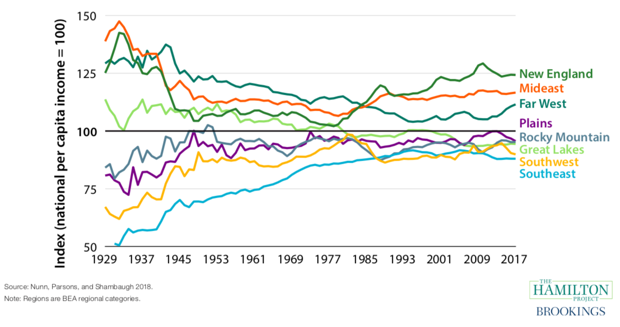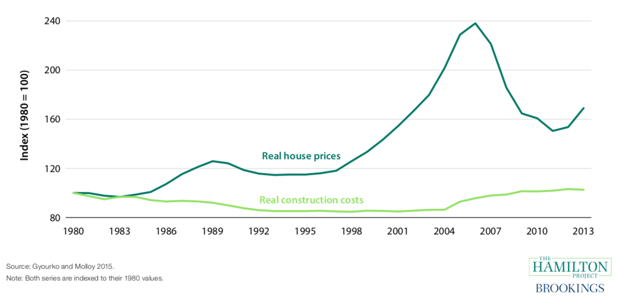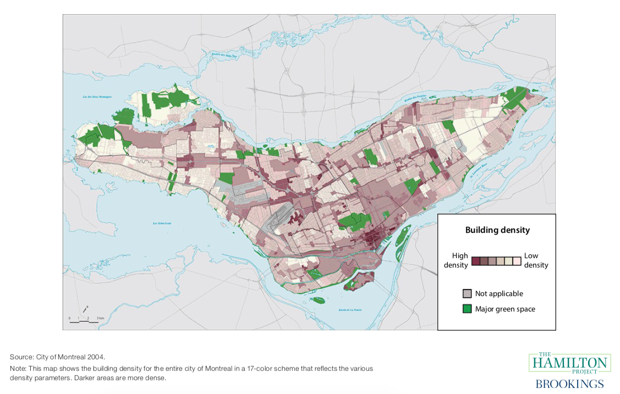How Affordable Housing Can Improve the American Economy

The chart below details the scope of the problem. For much of the 20th century, economic outcomes were converging across the United States. But that began to change by the 1970s, with the decline in manufacturing and the onset of the knowledge economy, as the economies of U.S. regions began to diverge.
Per Capita Income Relative to the National Average by Region,
1929-2017

The big problem today is not just economic inequality, but growing geographic inequality. The study arrays some startling statistics on the scope of this geographic divide.
- Nearly 60 percent of adults between the ages of 25 and 34 in Boston have graduated from college, compared to less than 20 percent in Lakeland, Florida.
- The obesity rate is nearly 40 percent in West Virginia versus 22.6 percent in Colorado.
- There’s a life expectancy gap of ten years between residents of Gadsden, Alabama (72.9 years of age) and those in San Jose, California (82.7 years of age).
A big part of the problem the study argues, stems from incredible differences in housing costs, which reflect underlying differences in productivity and lock many less-advantaged people out of these gains. In the most productive parts of the United States, like the San Francisco Bay Area and the New York-Boston-Washington corridor, housing prices have risen far faster than in the rest of the country. And the chart below shows housing costs have risen far faster than the costs of construction, meaning much of the surplus being generated, especially in expensive cities, has been channeled directly into the rising cost of land.

These implications are all too clear in the next chart that shows the fraction of homes in various metros that exceeds the standard affordability threshold of 30 percent of income. (The chart focuses on affordability as it pertains to working- and middle-class families; it does not include those below the poverty line). San Francisco, New York, Boston, Los Angeles, Seattle, and Miami all have a disproportionate share of cost-burdened households by this measure.
Percent of Housing Units that Are Cost-burdened, Selected Cities

How should governments deal with the nexus of housing and productivity, one that limits economic opportunity for less-skilled workers and holds back economic growth across the board?
The study puts land-use restrictions, which limit the supply of housing in innovation centers, on the front burner. But it also argues that solving the problem requires developing new strategies to address housing affordability for blue-collar workers and disadvantaged groups.
The study looks for inspiration from innovative efforts in several cities across the world:
Tokyo has liberalized housing regulation significantly to develop more housing. It permitted much new housing at greater densities and heights, enabling it to alleviate a once-massive housing problem. It also has an extensive subway and transit system that allows residents to commute efficiently from significant distances.
Montreal has focused on the development of low- and mid-rise apartments, instead of tall skyscrapers or single-detached homes. It’s far more affordable than Toronto or Vancouver, cities that rank among the most expensive in the world. In fact, more than three-quarters of the city’s residences are apartments in duplexes, row houses, semi-detached houses, or other buildings with fewer than five stories, more than double the 35 percent figure for Canada as a whole. The housing was often designed to be produced inexpensively. By investing moderate amounts to build mid-level housing, rather than a few expensive skyscrapers, the city has solved the “missing-middle” problem, creating family-sized housing at affordable costs.

Vienna has redefined public housing in ways that work for it. Nearly 60 percent of the city’s residents—including middle-class residents, not just those who are low-income—live in houses that are owned, built, or managed by the government. In addition, their rents are tied to both income and maintenance, which helps ensure that the properties are kept in good shape. While public housing is thoroughly debated in America, Vienna produces more housing per resident than other similarly sized European cities and has one of the lowest house price-to-income ratios in Europe.
“Demand-side policies are strong complements to an easing of land-use restrictions,” the authors write. “Promoting demand-side subsidies alongside movements to allow market-rate construction is not just sound politics—it is sound economics. These affordability programs will provide better bang for the buck when housing supply is less restricted.”
Ultimately, the study makes the critically important point that there is no magic bullet solution to America’s housing-inflected economic woes. Policies to increase supply by developers and demand by less-advantaged residents need to be seen as complementary strategies to be implemented together.
Source: citylab.com















 Accessibility
Accessibility